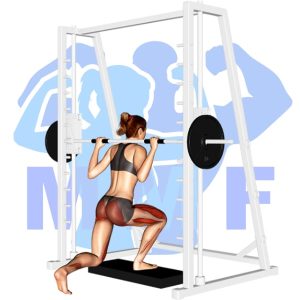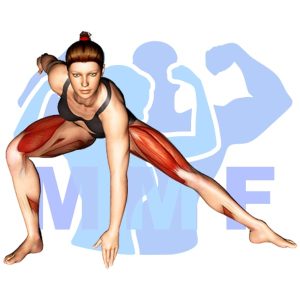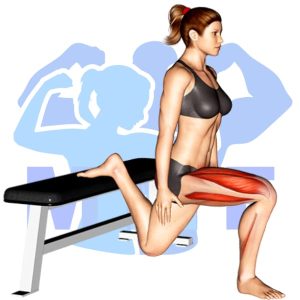Are you struggling to hit your squat PR? Do you feel like no matter how hard you try, you just can’t seem to get lower in your squats? Don’t worry, you’re not alone. Squatting is an essential exercise that can be challenging for many. One common cause of this problem is a lack of mobility in the hips and ankles, making it difficult to achieve proper form. But fear not, because in this post, we’ll be providing you with tips and exercises to improve your squat form and help you finally achieve your PR goals.
Squat Summary
- Primary Muscles: Quadriceps
- Secondary Muscles: Adductor Magnus, Gluteus Maximus, and Soleus
- Equipment: Body Weight
- Mechanics Type: Compound
- Force: Push
- Utility: Basic or Auxiliary

Squat Instructions
- Stand with your arms extended forward, feet shoulder-width apart, and your toes slightly pointed out.
- Squat down by bending your hips back while allowing your knees to bend forward, keeping your back arched with good posture and your knees pointed in the same direction as your feet.
- Descend until your thighs are just past parallel to the floor, or as far a comfortable.
- Press up by extending knees and hips until your legs are straight.
- Return and repeat these squats for 10-30 reps.
Video Tutorial
Squat Muscles
Target (Agonist)
Synergists
- Adductor Magnus
- Gluteus Maximus
- Soleus
Dynamic Stabilizers
Stabilizers
- Erector Spinae
- Levator Scapulae
- Trapezius – Middle
- Trapezius – Upper
Antagonist Stabilizers

Benefits of Squat
The squat is one of the most beneficial exercises for strength training or fitness routines, especially for targeting the quadriceps. Squats help to strengthen the quadriceps muscles, which are the four muscles at the front of the thigh. Squats also help to increase overall leg strength, improve balance and stability, and increase flexibility in the hips and ankles. When done correctly, squats can also help reduce the risk of injury in the lower body and reduce the risk of lower back pain. Furthermore, squats can be easily adapted to different levels of ability, making them an excellent exercise for both beginner and experienced exercisers alike.
Tips for Performing Squat
You’ve come at the right location if you desire to advance your capability to conduct squat. These tips can allow you to benefit fully from this first-class workout and make the best of its results. You’ll be able to shape your legs muscles, and minimize your risk of getting hurt. Let’s start now and see what these tips may achieve for you.
- Make sure your feet are shoulder-width apart: This will ensure your weight is properly distributed and help you get the most out of your squat.
- Keep your back straight: Keeping your back straight during the exercise will help you maintain proper form and prevent injury.
- Keep your chest up and shoulders back: This will help you engage your core muscles and make the exercise more effective.
Benefits and Tips Video
Frequent Mistakes To Avoid
Avoiding common errors can be the distinction between a productive training session and an injury when executing squat. Also, in order to maximize your benefits of the exercise, proper form is critical. By avoiding common mistakes, you will raise your performance and get your desired results. Don’t worry, though, it’s not nearly as hard as it may appear. You can execute the exercise safely and efficiently by avoiding the errors to avoid and by executing the correct steps. So it is time for you to maximize your results from this exercise and experience the benefits of a successful workout.
- Not going low enough: Many people tend to do a shallow squat and not go as low as they should. This can be an issue because you won’t be able to engage the right muscles and reap the full benefits of the exercise.
- Not engaging the core: Squats require your core to be engaged in order to maintain proper form, but people often neglect this and don’t engage their core while performing the exercise. This can lead to poor form which can lead to injury.
- Not using proper posture: When doing squats, it’s important to keep your back straight and not lean forward at any point. Leaning forward during a squat can put a lot of strain on your lower back and can lead to injury.
Find More Bodyweight Exercises Here
Variations and Complementary Exercises
If you’re looking to mix up your workout routine, there are plenty of variations, complementary, and alternative exercises that you can use to target the same muscles as the traditional Squat. Each of the following exercises works the same muscles as the Squat, providing an effective alternative to the traditional exercise.
Smith Machine Rear Lunge

The Smith Machine Rear Lunge is an excellent alternative or complementary exercise to the Squat. This exercise is performed by standing in front of a Smith Machine with the bar set at shoulder height. The exerciser then steps back with one leg, flexing the knee and hip of the trailing leg to lower down until the back knee almost touches the floor. The exerciser then returns to the starting position. This exercise emphasizes on strengthening the quadriceps and glutes of the leading leg, while also working on balance and stability. It is especially beneficial for those who are unable to perform traditional Squats due to lower back or knee issues.
Plyo Split Squats

Plyo Split Squats are an excellent alternative or complementary exercise for the traditional Squat. This exercise requires you to perform a deep lunge position, with one leg in front of the other. The added benefit of this exercise is that it requires you to generate power and explosiveness while also strengthening the legs. Additionally, Plyo Split Squats can help improve balance and coordination, as well as increase stability in the core muscles. This exercise can be used as an alternative to regular Squats, or can be used as an addition to regular Squats, in order to further increase strength and power.
Plyo Side Lunge

The Plyo Side Lunge is a great complementary or alternative exercise to the traditional Squat. It is a plyometric exercise that focuses on dynamic movement and explosive power, while still targeting the same muscle groups as the Squat. The Plyo Side Lunge requires you to jump to the side and land in a lunge position, with one leg bent and the other leg straight and extended. This exercise helps to build coordination, balance, and agility while still working the same muscles as a Squat. It is an effective way to change up your workout routine while still targeting the same muscle groups.
Check Out These Top Bodyweight Exercises
Half Squat

The Half Squat is a variation of the Squat that targets the same muscle groups, but reduces the range of motion. By only performing the lower portion of the Squat, you can reduce the risk of injury while still engaging the hips, glutes, hamstrings and quads. Half Squats are a great complementary exercise for those who have difficulty performing full Squats due to mobility issues or other physical limitations. They are also an effective alternative to full Squats if you are looking for a way to mix up your routine and challenge your muscles in new ways.
Bulgarian Split Squat

The Bulgarian Split Squat is an effective exercise that can be used to increase the strength and stability of the lower body. It is a great complementary or alternative exercise to the traditional Squat. The Bulgarian Split Squat puts more emphasis on the quads and glutes, which can help to strengthen and stabilise the hips and knees. Additionally, it can help to improve balance and coordination by requiring a single leg stance. It can be done with just your bodyweight or with added weight for more resistance. Performing Bulgarian Split Squats regularly can help to improve overall lower body strength and mobility.
Dumbbell Split Squat

Dumbbell Split Squat is a complementary or alternative exercise to the Squat. It is an excellent unilateral exercise that strengthens the quads, glutes, and hamstrings while also working on core stability. The split squat requires you to balance on one foot while you lower your body towards the ground, while the other leg is extended behind you. This move can help increase hip mobility, improve balance, and challenge your body in a new way. It is a great exercise for those who want to add variety to their Squat routine, or for those who are unable to perform the traditional Squat due to injury.
Find More Legs Exercises Here
Opposing Complementary Exercises
Squats are great for strengthening your lower body muscles, but it’s important to remember to balance out those muscles with exercises that target the opposing muscles. Incorporating these exercises into your workout routine helps keep your muscles in balance and can help prevent injury. Here are some exercises that can help:
Resistance Band Single Leg Curls

Resistance Band Single Leg Curls are a great exercise to complement Squats, as they focus on the opposing muscle group of the lower body. By performing single leg curls, you will be working the hamstrings and glutes, which will help to strengthen and balance the opposing muscles used during the squat. The resistance band allows for a more intense workout, as the tension increases as you pull the band further away from your body. This will help to improve your stability and coordination when performing Squats, as well as help to prevent injury.
Resistance Band Leg Curls

Resistance band leg curls are a great way to complement squats by targeting the opposing muscle group. This exercise works the hamstrings, glutes, and calves while squats primarily target the quads. By including this exercise in your routine, you will be able to strengthen both your quads and hamstrings, helping to improve your overall performance. Resistance band leg curls can also be done while standing or seated and can be adjusted to match your strength level. Additionally, it is a great way to add variety to your workout routine, as it can be done with a partner or on your own.
Smith Machine Hip Thrust

The Smith Machine Hip Thrust is an effective exercise for strengthening the glutes and hamstrings, which are the opposing muscle group to the quads used in a Squat. This exercise is excellent for improving overall lower body strength and stability and can be used to help complement a Squat workout by adding variety and intensity. The Smith Machine Hip Thrust also helps improve hip mobility and range of motion. It is an effective way to target the posterior chain, which is important for overall strength, power, and mobility.
Squat Your Way to a Healthier You!
Squats are one of the most effective exercises you can do to improve your overall health. They target your legs, glutes, and core while also promoting healthy bones and lean muscle mass. Squats can improve your balance and coordination, help prevent injuries, and boost your metabolism for weight loss. With so many benefits, it’s no wonder why they are a staple in any fitness routine. Whether you’re a beginner or advanced, there are many variations of squats that can be tailored to your fitness level. Give squats a try and squat your way to a healthier you!
References: Wikipedia | ExRx.net | PubMed.gov | Comprehensive List of Legs Bodyweight Exercises

